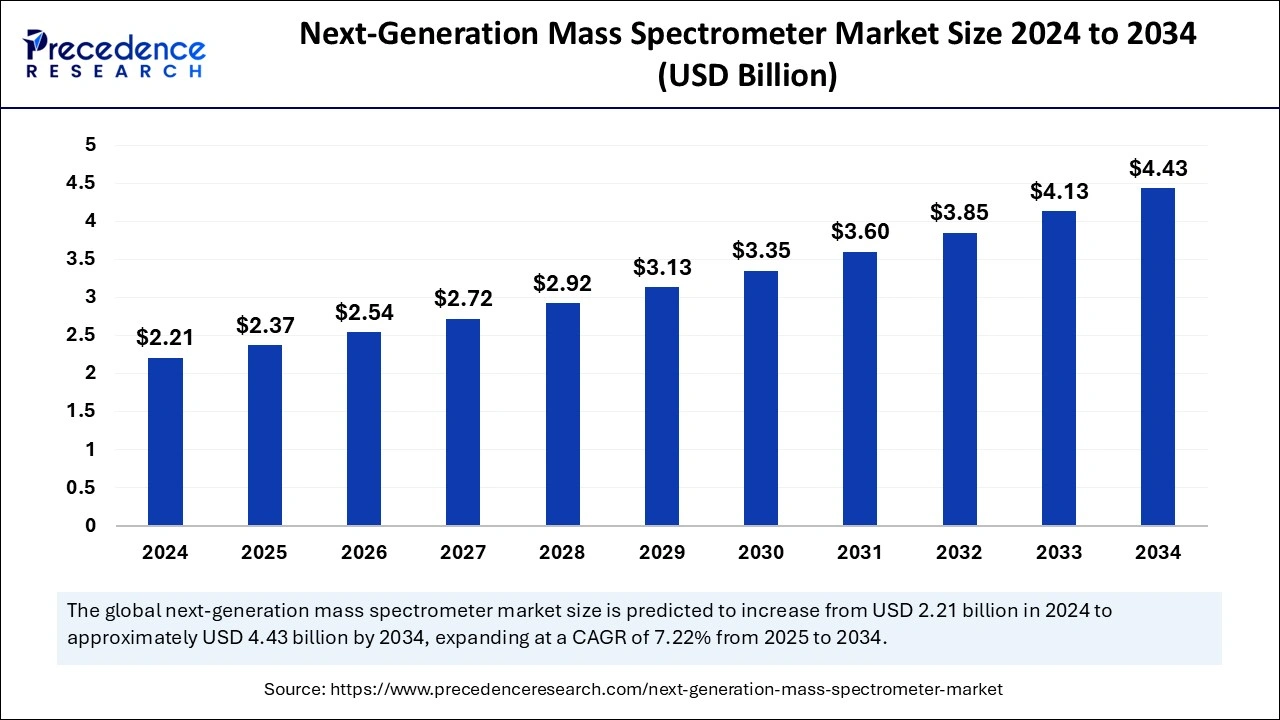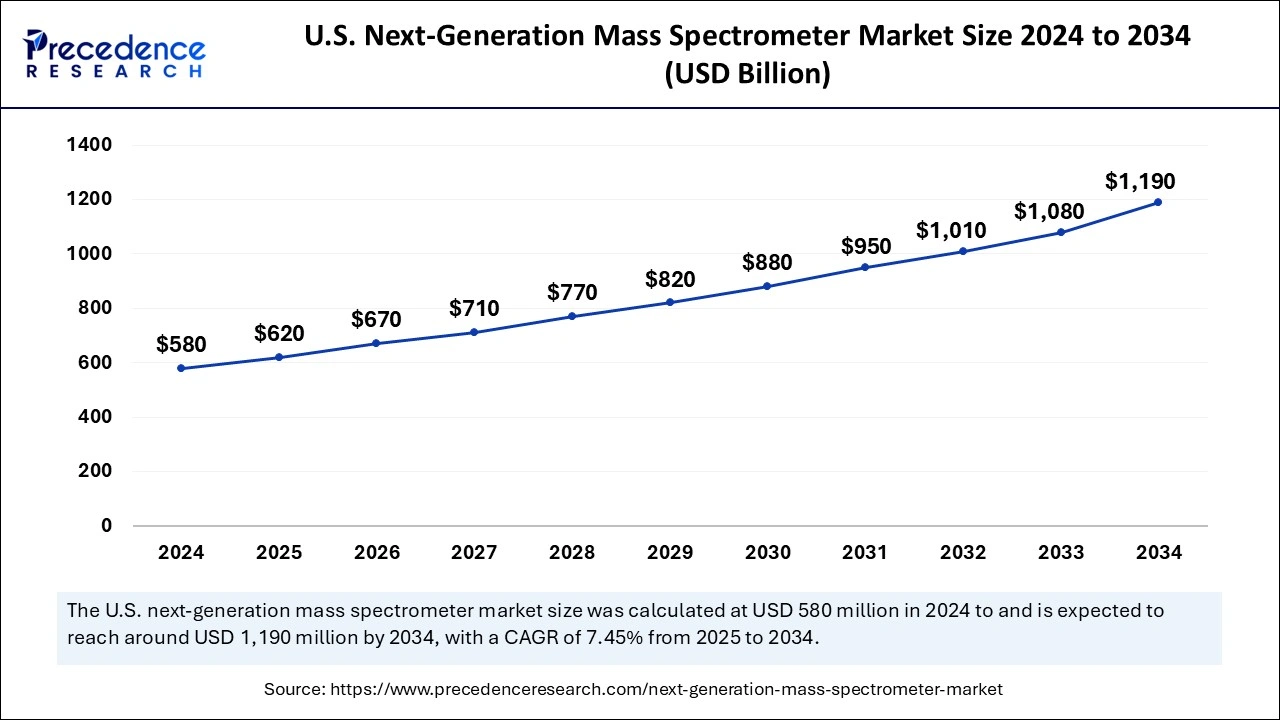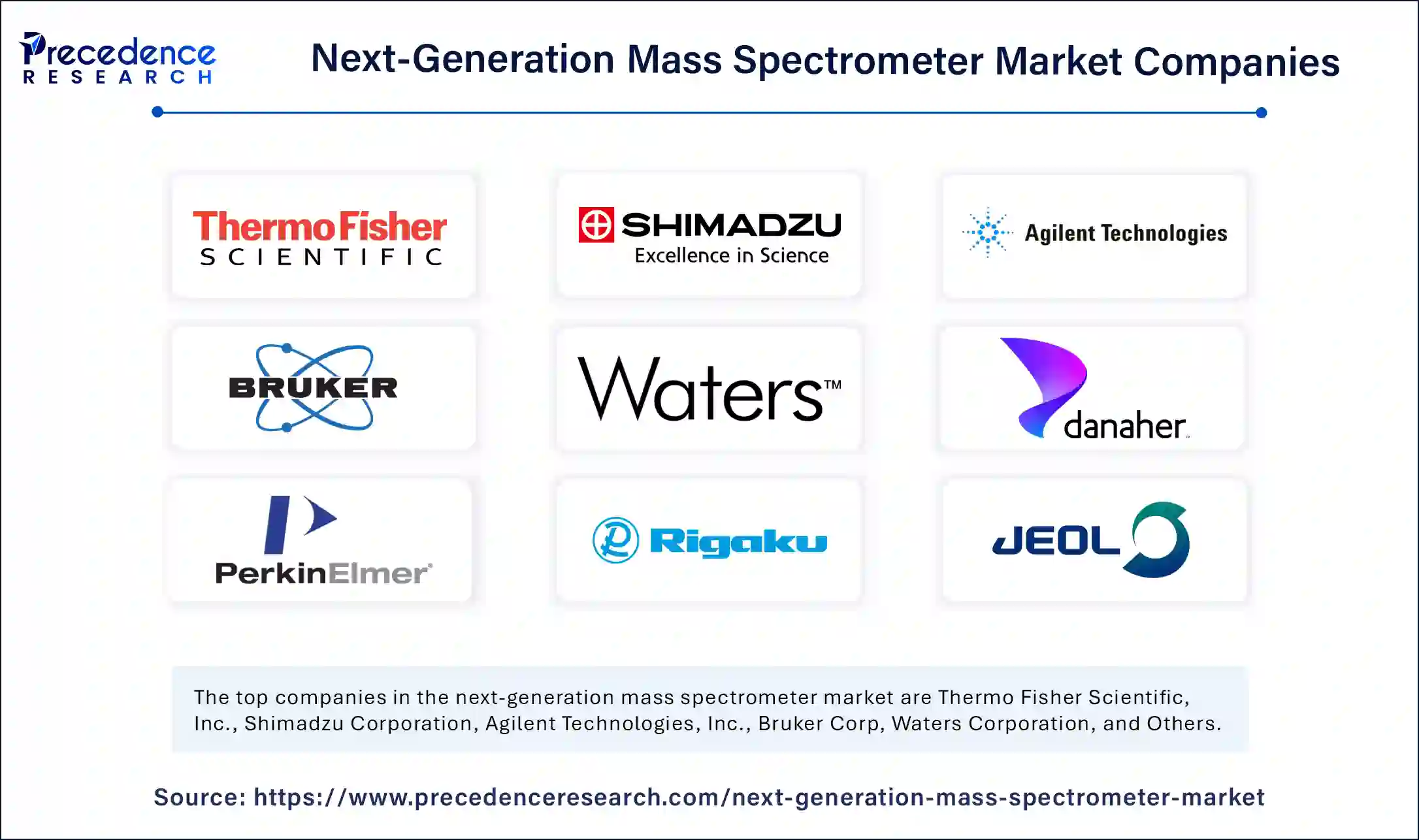January 2025
The global next-generation mass spectrometer market size is accounted at USD 2.37 billion in 2025 and is forecasted to hit around USD 4.43 billion by 2034, representing a CAGR of 7.22% from 2025 to 2034. The North America market size was estimated at USD 770 million in 2024 and is expanding at a CAGR of 7.38% during the forecast period. The market sizing and forecasts are revenue-based (USD Million/Billion), with 2024 as the base year.
The global next-generation mass spectrometer market size was calculated at USD 2.21 billion in 2024 and is predicted to increase from USD 2.37 billion in 2025 to approximately USD 4.43 billion by 2034, expanding at a CAGR of 7.22% from 2025 to 2034. The next-generation mass spectrometers experience rapid growth due to technological innovation, rising healthcare and pharmaceutical needs, environmental monitoring, government investments, and miniaturization for field applications.

The application of artificial intelligence, together with machine learning technologies, is revolutionizing the next-generation mass spectrometer market by replacing manual data processing while identifying concealed patterns in large datasets. AI-powered systems enhance the methods used in proteomics and metabolomics by delivering more precise results combined with better effectiveness levels. The worldwide market gains a substantial opportunity from integrating automation and AI with mass spectrometry. Modern laboratories benefit from automated processes that optimize sample analytics and boost laboratory test speed and efficiency rates.
The U.S. next-generation mass spectrometer market size was exhibited at USD 580 million in 2024 and is projected to be worth around USD 1,190 million by 2034, growing at a CAGR of 7.45% from 2025 to 2034.

North America accounted for the largest next-generation mass spectrometer market share in 2024. The expansion of the market in the area is propelled by the presence of key players and advanced industrial sectors. Moreover, the utilization of advanced and portable mass spectrometers boosts market growth. The regional market is led by the United States, with Canada and Mexico. The existence of leading pharmaceutical and biotechnology firms, paired with sophisticated research facilities and robust government support for scientific inquiry, has greatly enhanced market expansion in North America.
The growing emphasis on personalized medicine and clinical diagnostics has heightened the demand for mass spectrometry technologies. The ongoing integration of cutting-edge technologies, along with increasing uses in clinical diagnostics, proteomics, and metabolomics studies, keeps propelling market growth in these nations.
Mass spectrometers of the next generation use modern technological approaches to analyze compound structures. The next-generation mass spectrometer market enables scientists to discover new compounds by identifying molecular structures and recognizing substances. Complete scan analysis becomes available with optimized mass spectrometry performance, which synergistically results in better quantification capabilities and retroactive data interpretation. Next-generation mass spectrometers receive continuous enhancements through innovative software tools, which significantly accelerate their resolution performance capabilities.
The next-generation mass spectrometer market experiences growth through technological developments combined with increased pharmaceutical research, growth in biotechnology activities, and enhanced government and private spending. The developed testing approaches enable mass spectrometry studies across multiple elements in complicated samples by enhancing the resolution power for component detection. The market has grown substantially because of advanced mass spectrometer implementation. The ongoing growth relies heavily on expanded investment in mass spectrometry research.
| Report Coverage | Details |
| Market Size by 2034 | USD 704.23 Billion |
| Market Size by 2025 | USD 351.71 Billion |
| Market Size in 2024 | USD 325.59 Billion |
| Market Growth Rate from 2025 to 2034 | CAGR of 8.02% |
| Dominated Region | North America |
| Fastest Growing Market | Asia Pacific |
| Base Year | 2024 |
| Forecast Period | 2025 to 2034 |
| Segments Covered | Type, Application, End-user, and Regions |
| Regions Covered | North America, Europe, Asia-Pacific, Latin America, and Middle East & Africa |
Rising adoption in clinical diagnostics
The enhanced use of next-generation mass spectrometer market technologies in clinical diagnostics occurs because it measures complex biological specimens that help develop personalized treatments and better identify diseases. Mass spectrometry functions in proteomic analysis to both determine and measure proteins linked with diseases like cancer. The system tracks diabetes and neurodegenerative disorder metabolic shifts in metabolomics research.
The identification of disease-related molecules using mass spectrometry enables medical professionals to discover biomarkers that enhance early disease diagnosis. With the next-generation mass spectrometer market technology, medical practitioners can obtain improved treatment personalization by developing therapies that match the distinct biological characteristics of individual patients. Researchers can use the analysis of breath, urine, and saliva samples to develop non-invasive diagnostic methods that improve both patient comfort and treatment compliance.
High-cost
Mass spectrometry instruments, with their services, have a negative impact on market development due to their expensive nature. The elevated financial pressure stems from both instrument operating prices and routine servicing fees for these devices. High expenses discourage facilities from implementing these sophisticated instruments, which reduces their accessibility to budget-sensitive organizations. The next-generation mass spectrometer market benefits various industries because of its increasing market demand, yet its premium costs potentially restrain market development and restrict the practical application of mass spectrometry in critical areas of study.
Miniaturization trends
A notable trend has developed in the miniaturization of mass spectrometry instruments, fueled by technological advancements that allow the development of portable analytical devices. This shift from conventional devices has aided the creation of more sophisticated miniaturized mass spectrometry systems for on-site evaluation. Miniaturization trends in the next-generation mass spectrometer market hav0065 created new possibilities for field analysis and broadened their range of uses. These compact systems, known as micro-electro-mechanical systems (MEMS) mass spectrometers, are gaining popularity in several sectors, such as scientific research, space organizations, and forensic labs.
The hybrid segment has generated a significant share of the next-generation mass spectrometer market in 2024. Hybrid mass spectrometry provides excellent resolution and mass precision, enabling various operational modes to analyze intricate samples with high specificity. Developments in technology in this sector, coupled with a rising demand from the biopharmaceutical and biotechnology sectors, are fueling growth in this segment. Hybrid mass spectrometers are composed of a minimum of two distinct types of mass analyzers set up in a sequence from the ion source to the ion detector, facilitating enhanced performance by integrating multiple mass analyzer elements.
The single mass spectrometer segment is projected to witness the fastest growth during the forecast period. Single mass spectrometry maintains prominence in both standard analytical applications and specialized fields despite its basic nature since it delivers adequate analysis to meet these requirements. Academic research labs and quality assurance applications rely on this technology for its dependable performance, simple control systems, and reasonable cost structure. The market expands its diversity through segments that deliver customized solutions to address unique analytical needs while complementing hybrid mass spectrometric capabilities.
The biotechnology segment noted the largest next-generation mass spectrometer market share in 2024. This sector grows because advanced biochemical research relies increasingly on mass spectrometry for vital work in biopharmaceutical discovery and development. The rising utilization of mass spectrometry for analyzing compounds, including proteins, peptides, carbohydrates, oligonucleotides, natural products, and drug metabolites, drives faster market growth. The application of nano-flow liquid chromatography with mass spectrometry technology drives their usage across diverse biotechnology fields.
The pharmaceutical segment is estimated to witness the fastest growth during the forecast period. The mass spectrometer applications across pharmaceutical studies span drug identification activities and product characterization functions. Mass spectrometry excels in pharmaceutical applications since its analytical method identifies compounds while maintaining molecular integrity throughout the process without modification to the sample. This technique supports biomarker research and therapeutic drug-tracking operations alongside pharmacogenomics investigations, leading to advances in individualized treatment programs. Corporate and government financial support for pharmaceutical research, government regulatory standards for drug safety and development, and pharmaceutical industry sector growth.
The hospitals segment noted the largest next-generation mass spectrometer market share in 2024. Several medical and clinical laboratories have started to integrate mass spectrometry into routine patient management for multiple applications, such as therapeutic drug monitoring, toxicology, and endocrinology. Mass spectrometers in medical facilities perform multiple clinical roles, including the analysis of respiratory gases, newborn screening, and cancer diagnosis. This analytical instrument is useful for examining various clinical conditions, such as diabetes and respiratory well-being.
The research centers segment is estimated to witness the fastest growth in the forecast period. A mass spectrometer is a device employed to recognize and examine materials by measuring the ratio of mass to charge of their ions. This enables scientists to accurately assess the chemical makeup of a sample. Research institutions frequently utilize mass spectrometers for a range of purposes, such as drug discovery, protein assessment, environmental surveillance, forensic analysis, clinical testing, and metabolic research. Leading research centers often possess specialized mass spectrometry facilities to identify and quantify particular molecules in a sample, thereby supporting various research domains.

By Type
By Application
By End-User
By Geography
For inquiries regarding discounts, bulk purchases, or customization requests, please contact us at sales@precedenceresearch.com
No cookie-cutter, only authentic analysis – take the 1st step to become a Precedence Research client
January 2025
April 2025
December 2023
September 2023